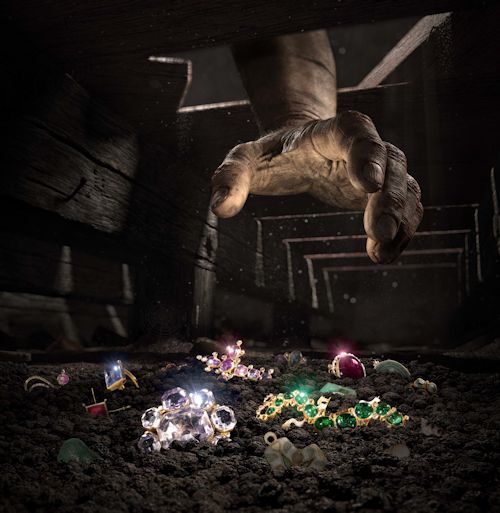The Cheapside Hoard: London’s Lost Jewels

©Museum of London
On the 18th June 1912, little over a month after the sinking of the “Titanic” a startling discovery was made by labourers demolishing three dilapidated buildings in the City of London, just a few doors west of Bow Bells. Whilst they demolished buildings which had been built after those destroyed by the Great Fire of London in 1666, some six feet below the brickwork they literally struck gold as they unearthed a stash of earth covered treasures, now known as the Cheapside Hoard. The hoard included; gold, jewels, rock-crystal dishes, carved gem figures, cameos, enamelled chains, clasps, bodkins, badges, buttons, beads, an exquisite perfume bottle and an emerald watch. They could not have known it at the time, but this was the stock-in-trade of a 17th-century jeweller which had been lying undisturbed for 300 years. The circumstances under which it was buried are still unknown.
The demolition workers took no time in taking their discovery to George F Lawrence, known as Stony Jack, an antique dealer, collector, pawn-broker and museum librarian. Over the years Stony Jack had befriended London’s labourers, encouraging them to bring him any finds. The workmen turned up at Stony Jacks Wandsworth shop with sacks containing great lumps covered with mud glinting with promise. Once he had sorted and washed everything, revealing its full splendour, he realised he was looking at a treasure of extraordinary beauty and monumental historical importance, one of the most significant finds to come from London’s soil and rubble. Stony Jack knew this collection belonged in a museum, and he thought of at once the newly established London Museum.
The London Museum as it was known at the time was situated next door to St James Palace. Within two days of the discovery, the museum had a hushed meeting with Stony and their trustees where they decided to keep the find secret until the hoard was officially acquired by the London Museum. The workmen who had discovered these treasures, for which they were handsomely rewarded, were too remained anonymous. Many visited the London Museum and the press went wild, but the display also sparked controversy over the rules of treasure trove, kindling intense rivalry among museums and academics. Questions were asked at the highest levels about the issue of ownership, yet the ruling by the Treasury (on behalf of the Crown) that had granted the Hoard to the London Museum stood.
Over the years experts have never been able to piece together why such a treasure had been left forgotten, or by whom it had once belonged. They have however been able to date within a few years of when the hoard had been buried. An overlooked intaglio has recently given a vital clue in dating the world’s finest collection of Elizabethan and Early Stuart jewellery. Blazoned with the heraldic badge of William Howard, the first and only Viscount Stafford, (1612-1680), new research has shown the 10mm x 8mm oval intaglio to be the latest datable item in the Hoard. Viscount Stafford was granted a peerage in 1640, a year or two before the Catholic peer had to flee persecution in Britain. The dating of this stone was a coup, yet it poses questions. Why was it in the jeweller’s shop? Perhaps for repair, or for setting into a signet ring, or perhaps it had been sold by the Stafford family before they left England. This alongside recent excavations at the site of discovery built over now by number One New Change that shows clear evidence of damage caused by the Great Fire of London in 1666 has seen the Museum of London accurately date the burial of the Hoard for the first time. Dated between 1640, when Stafford was granted the peerage and before 1666, when the Great Fire of London ravaged the city.
London Time

Follow Us
The contents of this website are the property of knowledgeoflondon.com and therefore must not be reproduced without permission. Every effort is made to ensure the details contained on this website are correct, however, we cannot accept responsibility for errors and omissions.
© Copyright 2004 -
Contact Us | Advertise